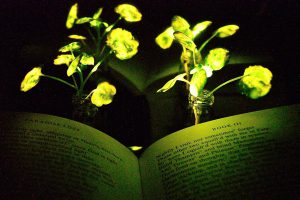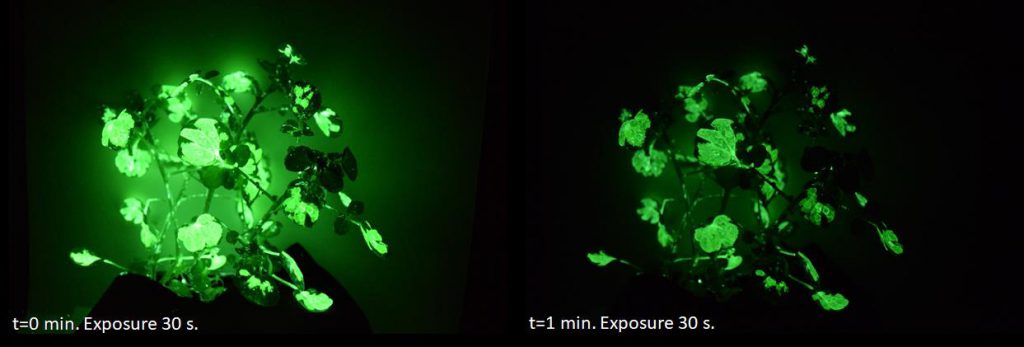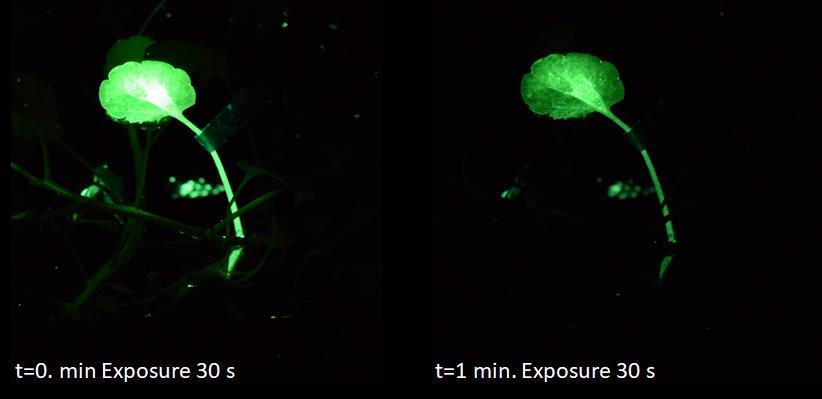
The Light Emitting Plant Project – Our Motivation
The global energy consumption attributed to direct and indirect lighting accounts for nearly 20% of demand, or 7 EJ/year and 2 Gt of CO2 emissions per year1. The engineering of living plants for visible light emission and sustainable illumination is compelling because plants possess independent energy generation and storage mechanisms, negative carbon footprints, and autonomous self-repair2. The goal of our laboratory at MIT is to develop the scientific and engineering basis for transforming a living plant or tree into an autonomous light source, capable to turning its own stored chemical energy into visible light for human use. We call this the Light Emitting Plant project. This project extends an overall aim of our laboratory to explore and develop what we call Plant Nanobionics – or the use of nanotechnology to enable living plants to manifest unique, non-native functions.
1 Waide, P., Tanishima, S. & International Energy Agency. Light’s labour’s lost : policies for energy-efficient lighting. (OECD/IEA, 2006)
2 Giraldo, J. P. et al. Plant nanobionics approach to augment photosynthesis and biochemical sensing. Nat Mater 13, 400-408 (2014)
The Light Emitting Plant – How it Works
Our concept uses a collection of chemically interacting nanoparticles that are injected into the plant, diffuse to specific cells and organelles, and transform the plant’s stored chemical energy into light emission. The project examines all aspects of this task, from the chemical synthesis and coating of different types of functional nanoparticles, biocompatibility within the plant, nanoparticle transport and localization, and theoretical modeling. The plant is not genetically altered in any way, and is not a GMO product.
The current generation of the plant utilizes firefly luciferase conjugated silica, D-luciferin releasing poly(lactic-co-glycolic acid), coenzyme A functionalized chitosan and in some versions semiconductor nanocrystal phosphors for longer wavelength modulation. An in vitro kinetic model incorporating the release rates of the nanoparticles was used to maximize the chemiluminescent lifetimes to exceed 21.5 hours. In watercress (Nasturtium officinale) and other species, the nanoparticles circumvent limitations such as luciferin toxicity above 400 µM and co-localization of enzymatic reactions near high adenosine triphosphate (ATP) production. A pressurized bath infusion method allows whole plant delivery of nanoparticles if the surface contact angle is below 113˚. Our mechanism of nanoparticle transport allows nanoparticle size and charge to control localization within distinct tissues compartments, with 10 nm nanoparticles localizing within the leaf mesophyll and stomata guard cells, and larger than 100 nm segregated in the leaf mesophyll. The results are mature watercress plants that emit greater than 7.5·1010 photons/sec or 15.5% of commercial luminescent diodes and modulate ‘off’ and ‘on’ by chemical addition of dehydroluciferin and coenzyme A, respectively.

Figure 1. The green light emission from watercress leaves was recorded with camera after short (5 s) exposure to blue light-emitting diode. Light intensity captured directly after excitation (0 min) and 1 min demonstrates monotonic decay over a time.

Figure 2. Modified single leaf and corresponding stem of watercress plant showed characteristic emission at the beginning (0 min) and 1 min, a clear indication of a single leaf and single stem modification.
The Cooper Hewitt Exhibit
This exhibit is actually a 33 week experiment testing the biocompatibility and durability of a nanoparticle component that we call the light capacitor. Such particles are engineered to have the property of taking in short but intense bursts of light emission and storing them for a prolonged discharge, thereby extending the lifetime of plant luminescence. The team at MIT has experimented with different types of plants, incubation times and conditions to maximize the viability of such particles. The exhibit, and the preparations for it, have provided valuable insight into how plant based lighting can be installed and sustain in the indoor environment.
Sponsors
The MIT Light Emitting Plant team is grateful for a grant from the Bose Foundation and to MQDC in Thailand for research funding.
![]()
